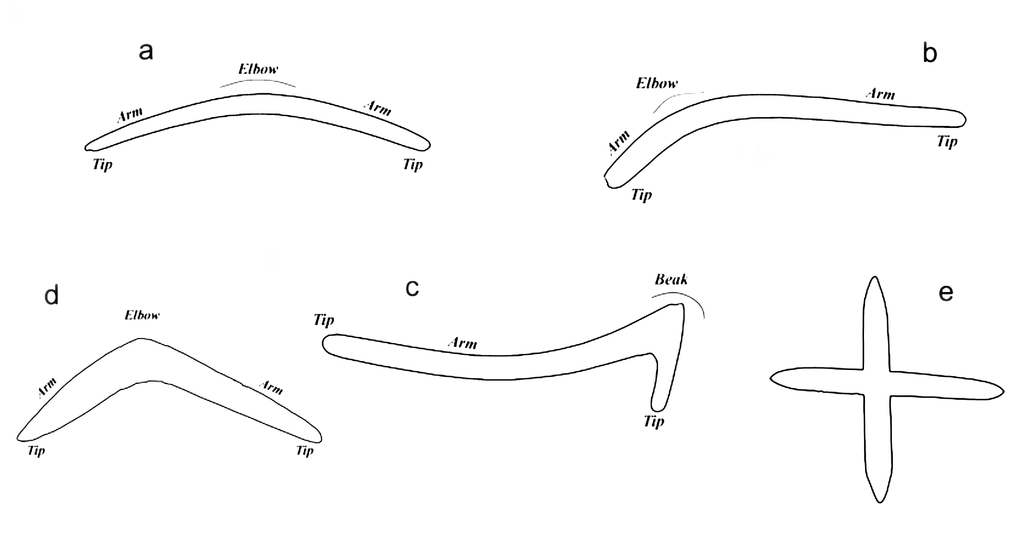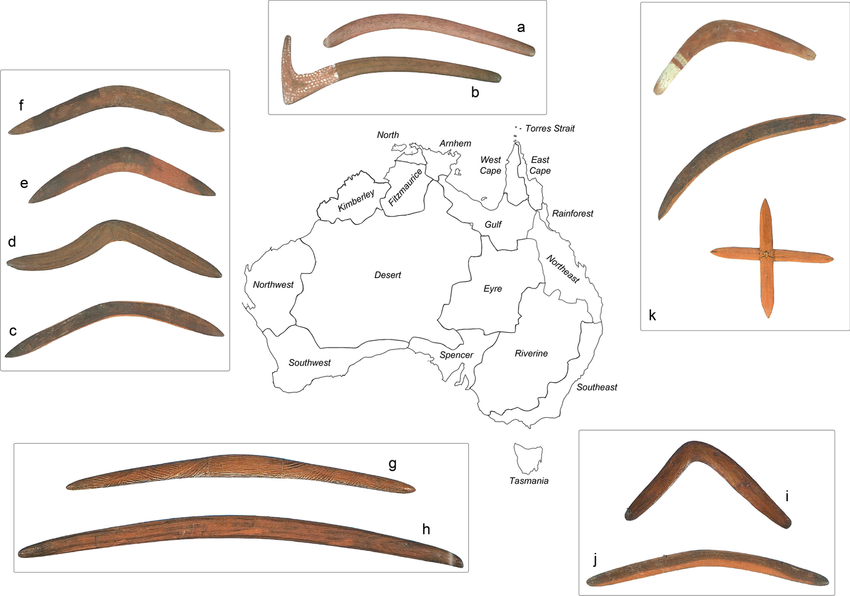The boomerang is an iconic symbol of Australia and a significant part of Aboriginal culture
These intricately designed tools hold deep historical and cultural significance, reflecting the craftsmanship and ingenuity of Aboriginal communities. The diverse styles of boomerangs found across Australia illustrate the variety of uses and regional influences that have shaped their designs over thousands of years.

Types of boomerang, and denomination of its morphological components; (a) symmetrical boomerang, (b) asymmetrical boomerang, (c) beaked or hooked boomerang, (d) returning boomerang, (e) cross-boomerang. (Drawings by E. F. Martellotta)
In northern Australia, particularly in Arnhem Land, boomerangs are crafted with a distinct, elongated shape, often symmetrical and rounded. This design is ideal for hunting and combat, allowing for straight flights that make them well-suited for striking targets, from small game to birds. Aboriginal communities in Arnhem Land also utilise the boomerang as a musical instrument, striking it against the ground or another boomerang to create rhythmic beats during ceremonies and dances.
Central Australia features the "returning boomerang," which has a unique curved design, crafted with a specific angle that allows it to circle back when thrown. This design is particularly useful for hunting birds, as it enables the hunter to cover a wider area. The returning boomerang is also a testament to the ingenuity of Aboriginal craftsmanship, reflecting an understanding of aerodynamics and balance. Beyond hunting, these boomerangs serve as symbols of cultural identity, often adorned with intricate carvings or paintings that tell stories or represent the heritage of the maker.
In southeastern Australia, boomerangs take on yet another form, with broader, flat, and asymmetrical designs. One side is often longer than the other, allowing for a straighter trajectory. This style is effective in open landscapes, making it suitable for hunting. Aboriginal communities in this region use boomerangs for various purposes, from hunting and digging to ceremonial practices.
In southwestern Australia, boomerangs take a different form, known as "cross-boomerangs," consisting of two pieces of wood joined together to form a cross. The design allows for a more stable flight pattern, making it effective for hunting small game. The cross boomerang's unique construction highlights the resourcefulness of Aboriginal communities, who crafted these tools to adapt to their environment and the types of prey they encountered.
The beaked or hooked boomerang, with its exaggerated curve, is another style found in some regions. Its sharp hook makes it effective for hunting, as it can strike targets at a variety of angles.
The various styles of boomerangs found across Australia reflect the diverse needs and cultural influences of Aboriginal communities. These tools serve as hunting implements, musical instruments, and symbols of heritage, embodying the ingenuity and adaptability of Aboriginal craftsmanship. The boomerang's enduring legacy is a testament to the deep connection between Aboriginal culture, the land, and its people, ensuring that this iconic tool continues to hold significance for generations to come.

Main morphological types of boomerangs and their geographic distribution throughout Australia. Boundaries and names of the regions follow the work created by David R. Horton (© AIATSIS 1996)
(a) asymmetrical, ochred, fluted boomerang (from Jones (2004, p. 17)). (b) hooked beaked boomerang (from Jones (2004, p. 87))—central Australia. (c) asymmetrical boomerang with sharpened tips (from Jones (2004, p. 90). (d) boomerang showing an unusual concavity on one of the arms (from Jones (2004, p. 90))—Western Australia. In the Kimberley, the asymmetrical shapes (e) are dominant in the coastal region (Jones, 2004, p. 82), whereas boomerangs from inland (f) have more traits in common with central Australia (Jones, 2004, p. 82). In the Eyre region, smaller boomerangs (g) were thrown, whereas longer boomerangs (h) were used in close contact fighting (Jones, 2004, p. 92). (i-j) symmetrical boomerangs from the Southeast (top) (from Jones (2004, p. 99)) and Spencer (bottom) (from Jones (2004, p. 103)) regions. (k) morphological variability of boomerang’s morphologies in the region corresponding to central and eastern Queensland (Jones, 2004, pp. 96–97). Jones, P. (2004). Boomerang. Behind an Australian Icon, Wakefield Press, Kent







